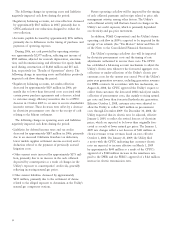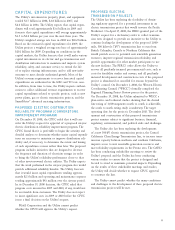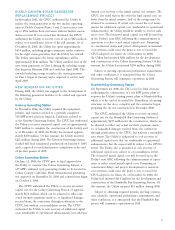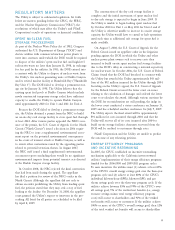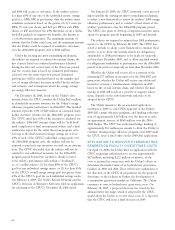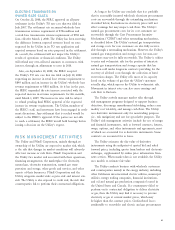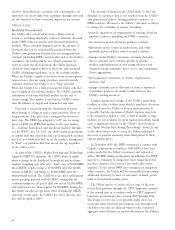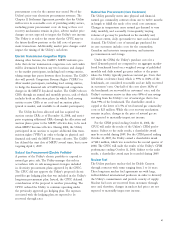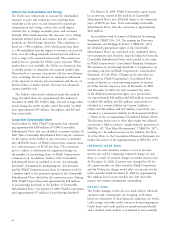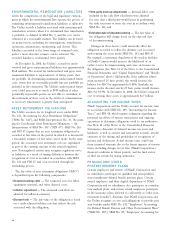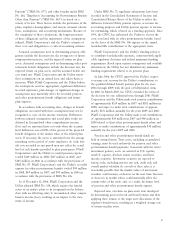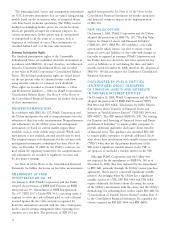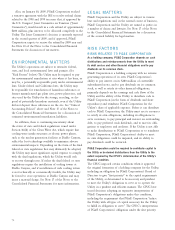PG&E 2008 Annual Report Download - page 64
Download and view the complete annual report
Please find page 64 of the 2008 PG&E annual report below. You can navigate through the pages in the report by either clicking on the pages listed below, or by using the keyword search tool below to find specific information within the annual report.62
The amount of electricity the Utility needs to meet the
demands of customers that is not satisfi ed from the Utility’s
own generation facilities, existing purchase contracts, or
DWR contracts allocated to the Utility’s customers is subject
to change for a number of reasons, including:
• periodic expirations or terminations of existing electricity
purchase contracts including the DWR’s contracts;
• the execution of new electricity purchase contracts;
• fl uctuation in the output of hydroelectric and other
renewable power facilities owned or under contract;
• changes in the Utility’s customers’ electricity demands
due to customer and economic growth or decline,
weather, implementation of new energy effi ciency and
demand response programs, direct access, and community
choice aggregation;
• the acquisition, retirement, or closure of generation
facilities; and
• changes in market prices that make it more economical
to purchase power in the market rather than use the
Utility’s existing resources.
Lengthy, unexpected outages of the Utility’s generation
facilities or other facilities from which it purchases electricity
also could cause the Utility to be in a short position. It
is possible that the operation of Diablo Canyon may have
to be curtailed or halted as early as 2010 if suitable storage
facilities are not available for spent nuclear fuel, which would
cause a signifi cant increase in the Utility’s short position
(see “Spent Nuclear Fuel Storage Proceedings” above). If any
of the above events were to occur, the Utility may fi nd it
necessary to procure electricity from third parties at then-
current market prices.
In December 2007, the DWR terminated a contract with
Calpine Corporation to purchase 1,000 MW of base load
power needed by the Utility’s customers and replaced it
with a 180 MW tolling arrangement. In addition, the DWR
may try to terminate or renegotiate other long-term power
purchase contracts it has entered into with other power
suppliers. To the extent DWR does terminate or renegotiate
other contracts, the Utility will be responsible for procuring
additional electricity to meet its customers’ demand, poten-
tially at then-current market prices.
The Utility expects to satisfy at least some of the fore-
casted short position through the CPUC-approved contracts
it has entered into in accordance with its CPUC-approved
long-term procurement plan covering 2007 through 2016.
The Utility recovers the costs incurred under these con-
tracts and other electricity procurement costs through retail
electricity rates that are adjusted whenever the forecasted
aggregate over-collections or under-collections of the Utility’s
activities from wholesale customers and counterparties are
expected to be recoverable from customers through rates and
are not expected to have a material impact on net income.
PRICE RISK
Electricity Procurement
The Utility relies on electricity from a diverse mix of
resources, including third-party contracts, amounts allocated
under DWR contracts, and its own electricity generation
facilities. When customer demand exceeds the amount of
electricity that can be economically produced from the
Utility’s own generation facilities plus net energy purchase
contracts (including DWR contracts allocated to the Utility’s
customers), the Utility will be in a “short” position. In
order to satisfy the short position, the Utility purchases
electricity from suppliers prior to the hour- and day-ahead
CAISO scheduling timeframes, or in the real-time market.
When the Utility’s supply of electricity from its own genera-
tion resources plus net energy purchase contracts exceeds
customer demand, the Utility is in a “long” position.
When the Utility is in a long position, the Utility sells the
excess supply in the real-time market. The CAISO currently
administers a real-time wholesale market for the sale of
electric energy. This market is used by the CAISO to fi ne-
tune the balance of supply and demand in real time.
Price risk is associated with the uncertainty of prices
when buying or selling to reduce open positions (short or
long positions). This price risk is mitigated by electricity
price caps. The FERC has adopted a “soft” cap on energy
prices of $400 per MWh that applies to the spot market
(i.e., real-time, hour-ahead, and day-ahead markets) through-
out the WECC area. (A “soft” cap allows market participants
to submit bids that exceed the bid cap if adequately justifi ed,
but does not allow such bids to set the market clearing price.
A “hard” cap prohibits bids that exceed the cap, regardless
of the seller’s costs.)
As part of the CAISO’s Market Redesign and Technology
Upgrade (“MRTU”) initiative, the CAISO plans to imple-
ment a change to the day-ahead, hour-ahead, and real-time
markets, including new offer price “hard” caps of $500/MWh
when MRTU begins, rising to $750/MWh after the twelfth
month of MRTU, and fi nally to $1,000/MWh after the
twenty-fourth month. The CAISO has also fi led tariff amend-
ments pending approval with the FERC stating that for
settlement purposes, all prices shall not exceed $2,500/MWh
and shall not be less than negative $2,500/MWh during the
fi rst twelve months of operation. After delaying the MRTU
start date several times, the CAISO has stated that the start
date will be April 1, 2009.


